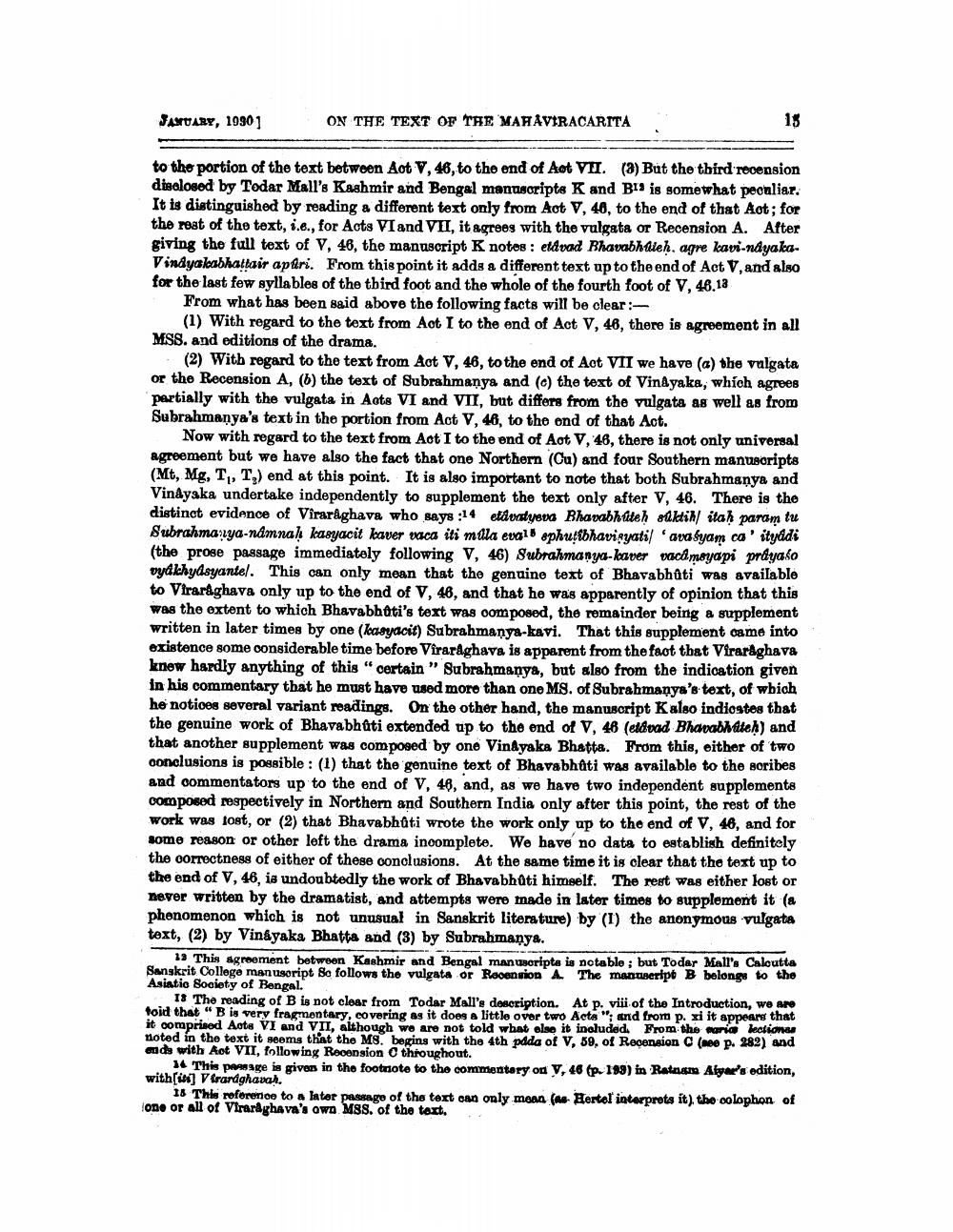________________
JANUARY, 19901
ON THE TEXT OF THE MAHAVIRACARITA
15
to the portion of the text between Act V, 46, to the end of Aot VII. (3) But the third recension disclosed by Todar Mall's Kashmir and Bengal manuscripts K and BI is somewhat peculiar. It is distinguished by reading a different text only from Act V, 48, to the end of that Aot; for the rest of the text, i.e., for Acts VI and VII, it agrees with the vulgata or Recension A. After giving the full text of V, 46, the manuscript K notes: etavad Bhavabhaleḥ, agre kavi-nayaka. Vinayakabhaṭṭair apari. From this point it adds a different text up to the end of Act V, and also for the last few syllables of the third foot and the whole of the fourth foot of V, 46.13
From what has been said above the following facts will be clear:
(1) With regard to the text from Act I to the end of Act V, 46, there is agreement in all MSS. and editions of the drama.
(2) With regard to the text from Act V, 46, to the end of Act VII we have (a) the vulgata or the Recension A, (b) the text of Subrahmanya and (e) the text of Vinayaka, which agrees partially with the vulgata in Aots VI and VII, but differs from the vulgata as well as from Subrahmanya's text in the portion from Act V, 46, to the end of that Act.
Now with regard to the text from Act I to the end of Act V, 46, there is not only universal agreement but we have also the fact that one Northern (Cu) and four Southern manuscripts (Mt, Mg, T, T2) end at this point. It is also important to note that both Subrahmanya and Vinayaka undertake independently to supplement the text only after V, 46. There is the distinct evidence of Viraraghava who says :14 etavatyeva Bhavabhuteḥ sûktih itaḥ param tu Subrahmanya-namnaḥ kasyacit kaver vaca iti mulla eval sphutibhavisyati avasyam ca' ityádi (the prose passage immediately following V, 46) Subrahmanya-kaver vacâmayapi prayako vyakhyasyantel. This can only mean that the genuine text of Bhavabhuti was available to Viraraghava only up to the end of V, 46, and that he was apparently of opinion that this was the extent to which Bhavabhuti's text was composed, the remainder being a supplement written in later times by one (kasyacit) Subrahmanya-kavi. That this supplement came into existence some considerable time before Viraraghava is apparent from the fact that Viraraghava knew hardly anything of this "certain" Subrahmanya, but also from the indication given in his commentary that he must have used more than one MS. of Subrahmanya's text, of which he notices several variant readings. On the other hand, the manuscript Kalso indicates that the genuine work of Bhavabhuti extended up to the end of V, 46 (etavad Bhavabhateḥ) and that another supplement was composed by one Vinayaka Bhatta. From this, either of two conclusions is possible: (1) that the genuine text of Bhavabhuti was available to the scribes and commentators up to the end of V, 46, and, as we have two independent supplements composed respectively in Northern and Southern India only after this point, the rest of the work was lost, or (2) that Bhavabhuti wrote the work only up to the end of V, 46, and for some reason or other left the drama incomplete. We have no data to establish definitely the correctness of either of these conclusions. At the same time it is clear that the text up to the end of V, 46, is undoubtedly the work of Bhavabhuti himself. The rest was either lost or never written by the dramatist, and attempts were made in later times to supplement it (a phenomenon which is not unusual in Sanskrit literature) by (I) the anonymous vulgata text, (2) by Vinayaka Bhatta and (3) by Subrahmanya.
13 This agreement between Kashmir and Bengal manuscripts is notable; but Todar Mall's Calcutta Sanskrit College manuscript So follows the vulgata or Recension A. The manuscript B belongs to the Asiatic Society of Bengal.
13 The reading of B is not clear from Todar Mall's description. At p. viii of the Introduction, we are toid that "B is very fragmentary, covering as it does a little over two Acts"; and from p. xi it appears that it comprised Acts VI and VII, although we are not told what else it included. From the varias lectionas noted in the text it seems that the MS. begins with the 4th pdda of V, 59, of Recension C (see p. 282) and ends with Act VII, following Recension C throughout.
14 This passage is given in the footnote to the commentary on V, 46 (p. 199) in Ratnam Aiyar's edition, with[it] Viraraghavaḥ.
18 This reference to a later passage of the text can only mean (as Hertel interprets it), the colophon of one or all of Viraraghava's own MSS. of the text.




